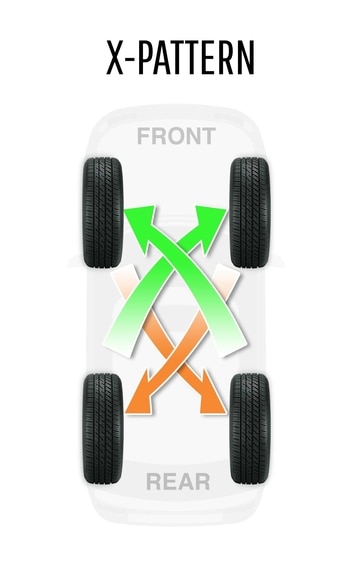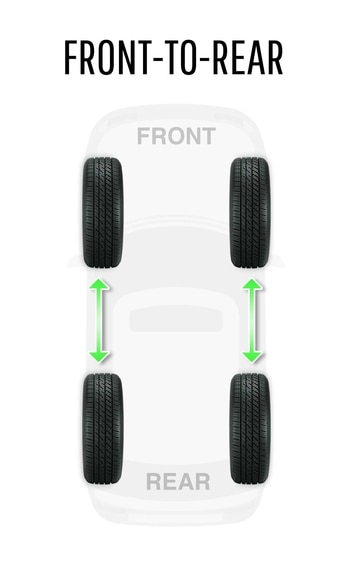Tire rotation, that is routinely repositioning your vehicle’s tires in specific patterns from front to back or side to side, is an important element of tire upkeep and safety. Additionally, rotating your tires may also be required to keep your tires covered under warranty. For a quick visual summary of tire rotation, check out our Tread Life episode about tire rotation. Read on for more information about what tire rotation is, why tire rotation patterns matter, and the correct pattern for your vehicle’s needs.
Find Your Bridgestone Service Center
WHAT IS TIRE ROTATION?
Tire rotation means periodically changing the position of each of the tires on your vehicle. You should rotate your tires as recommended by the vehicle manufacturer, or every 5,000 miles. For many of you, that will mean when you get your vehicle’s oil changed.
Regularly rotating your tires also gives you a good opportunity to visually inspect them for damage, check their air pressure, have them rebalanced if you’re noticing any vibration, and check their tread depth.
WHY IS TIRE ROTATION IMPORTANT?
There are several reasons why tire rotation is an important element of your standard tire care. First, by routinely rotating your tires, wear is spread evenly across all four tires, and their tread life is maximized. That’s because each specific position on your vehicle requires a different give from each tire—(for example, tires on the front of a front-wheel drive vehicle will take a larger proportion of the torque and friction that’s needed for turning, accelerating and braking)—and can lead to more, or less, wear on the tire. It is especially important to rotate new tires by 5,000 miles because deep, fresh tire tread is more susceptible to uneven wear.
Secondly, even tread wear keeps the tread depth on your tires uniform, which can help keep traction and handling consistent across all four tires. This will improve cornering and braking performance and keep your vehicle safer for driving overall.
Finally, if your vehicle has all-wheel-drive, evenly worn tires lower the stresses on the drivetrain, reducing wear on expensive drive components.
WHAT TIRE ROTATION PATTERN SHOULD I UTILIZE?
The tire rotation pattern that’s best for your vehicle will depend on the type of tire you’re using, whether your vehicle is front, rear, all, or four-wheel drive, whether your tires are directional or non-directional, whether or not your tires are the same size on the front and rear of your vehicle, and whether you have a full-size spare that can be rotated through as well, unlike a temporary spare.. Let’s take a look at tire rotation patterns recommended by the standardizing body of the tire industry, The Tire and Rim Association, Inc., for all of these possibilities.



SAMPLE VISUAL:
FOR TIRES THAT ARE OF UNIFORM SIZE AND NON-DIRECTIONAL:
1. REARWARD CROSS
For vehicles that are rear wheel drive vehicles, the rearward cross pattern is recommended. Rear tires are moved to the forward axle and kept on the same side of the vehicle while the front tires are moved to opposite sides of the rear axle.
2. X-PATTERN
Recommended for 4-wheel and all wheel drive vehicles such as light-weight trucks and sedans, all tires are moved diagonally, meaning tires are switched from one axle to the opposite as well as being repositioned from one side to the other.
3. FORWARD CROSS
This is the most common pattern for front-wheel drive vehicles. The front axle tires are moved directly back while the rear tires are moved up diagonally to the opposite side of the front axle.
FOR TIRES THAT ARE OF UNIFORM SIZE AND NON-DIRECTIONAL WITH A FULL-SIZE SPARE TIRE:
In order to insure that all of the tires on your vehicle have even tread wear, you’ll want to be sure to rotate your full-size spare tire along with the other four. This is especially vital for all-wheel or 4-wheel drive vehicles where even small differences can put undue strain on your car’s drive train.
1. REARWARD CROSS (REAR-WHEEL OR 4-WHEEL DRIVE VEHICLES):
Both rear axle tires move directly forward to the front axle while the spare tire moves to the right side of the rear axle. The right front tire moves diagonally back to the left side of the rear axle while the left front tire becomes your new spare tire.
2. FORWARD CROSS (FRONT-WHEEL DRIVE VEHICLES):
Rear tires are moved diagonally to opposite sides on the front axle while the right front tire becomes the new spare tire. The spare tire is positioned on the right side of the rear axle while the left tire on the front axle is moved directly back into the left rear position.
SAMPLE VISUAL:


FOR HIGH PERFORMANCE AND DIRECTIONAL TIRES:
1. SIDE-TO-SIDE (FOR DIFFERENTLY-SIZED PERFORMANCE TIRES ON THE FRONT AND REAR AXLES)
All tires are switched with their same-sized partner and remain on the same axle. The two rear tires switch to the opposite side with one another while the two front tires do the same.
2. FRONT-TO-BACK (FOR DIRECTIONAL TIRES)
All tires are moved from one axle to the other but remain on the same side of the vehicle. For example, the front left tire is moved to the left side of the rear axle while the rear left tire is repositioned on the left side of the front axle.





